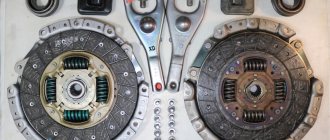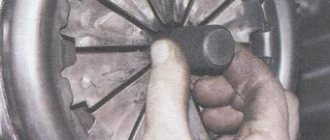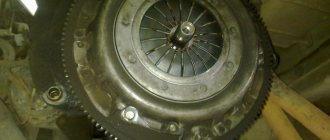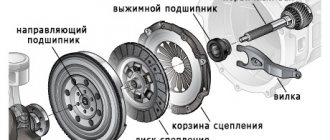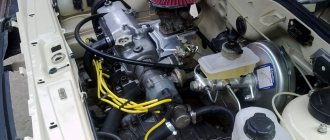Cars of the 09 VAZ family are equipped with a cable-operated clutch. This technology is 5 times more reliable than classic variations with hydraulic drive. However, during operation, any mechanism requires calibration and this unit is no exception. A scheduled inspection must be performed every 15,000 km or once a year, whichever comes first. However, unexpected breakdowns occur that require surgical intervention.
The following factors are considered signs of incorrect operation of the unit.
- The car starts moving jerkily - the clutch slips, which causes uneven acceleration.
- Increase in fuel consumption by approximately 10-15%.
- Dissonance between engine speed and actual acceleration of the car.
- When shifting into gear, extraneous sounds and squeaks are heard from the gearbox.
- When inspecting the car, there is an unpleasant smell of burnt pads.
- The pedal falls or sticks.
- The drive does not operate in the middle of the pedal stroke.
If even 1 of the listed points is detected, the design must be adjusted.
Why do you need clutch adjustment?
Adjustment is necessary due to normal wear and tear. Between the basket and the disc there are friction linings that are subject to abrasion. Consequently, after grinding them down, the pedal rises and the unit acts up.
The second reason is stretching of the clutch cable. As its length increases, similar defects occur.
When is it necessary to adjust the pedal?
VAZ 21093 clutch adjustment
Adjusting the VAZ 2109 clutch is necessary because:
- If this is not done, your car will soon need to be repaired. This is because it will supply too much energy for the pedal to operate properly.
- Due to improper operation, the clutch pedal is partially disengaged. This causes the clutch disc to contact the engine flywheel, causing them both to wear out.
- If the pedal travel is insufficient, the car slips, that is, there is a loss of wheel torque.
Clutch operation diagnostics
To understand whether the clutch is working correctly, just follow the procedure.
- Take a ruler and place it on the floor. The other end of the meter should be attached to the bottom of the pedal. It should be approximately 18-19 centimeters.
- Press the lever all the way and measure the distance again - normally it will be 7-8 cm.
- It is considered normal when the difference between the readings is 13.5-14.5 cm.
If there is a deviation in the parameters from the norm by more than 20 mm, the drive needs to be adjusted.
Nine clutch device
The clutch kit is one of the key components of the Nine transmission. This is a single-disc friction-type mechanism located between the engine and the gearbox (gearbox). The algorithm for its operation is as follows:
- Initially, the car is stationary, the engine is started, the pedal is released. The gearshift lever is in the neutral position, that is, the rotation of the input shaft is not transmitted to the secondary shaft.
- The driver is preparing to move forward. With his left foot he presses the pedal, and the mechanism disconnects the gearbox input shaft from the engine. The driver moves the lever to the first gear position, the mechanism ensures the engagement of the primary and secondary shafts of the gearbox. The car is stationary because the engine is disconnected from the transmission input shaft.
- The driver smoothly but decisively releases the pedal. The engine is connected to the input shaft, the task of which is to transmit power to the drive wheels through the secondary shaft, then the car will start moving.
- Switching from first gear to second, from second to third, and so on occurs in the same way.
The VAZ 2109 clutch design is such that when the pedal is released, the driven disk is clamped by springs between the flywheel and the pressure plate. In this case, power is transferred to both gearbox shafts and the drive wheels. When you press the pedal, the VAZ 2109 clutch fork rotates through a special rod and presses on the levers that retract the pressure plate. The VAZ 2109 clutch driven disc is disconnected and power transmission stops. The mechanism casing is connected to the pressure plate by three pairs of elastic plates. The unit is driven by a cable, its lower tip is fixed with nuts in a bracket on the engine crankcase.
The clutch cable is connected to the clutch release fork lever.
Replacing the clutch cable on a VAZ 2109
Installing a new part is easy. There is only primitive mechanics here, based on the transfer of energy through a cable.
Reasons for replacement
The reason for repair may be clutch slipping or difficulty shifting gears. It often happens that the cable breaks due to a sudden load or jerk - this becomes the main source of problems.
Replacement
Performed in 2 ways. You will need a simple set of tools and 30 minutes of personal time.
Taking off the frill
A complex procedure involves many unnecessary steps, but if there is a question, there will be an answer.
- Drive the car into the inspection hole.
- Unscrew the cable from the pedal and remove it.
- Next, remove the frill and windshield wiper and open the hood.
- Then you should find the place where the cable is attached to the car. Unscrew it.
- Remove the old line and install a new one in its place.
Without removing the frill
You can replace the cable at home like this.
- Remove the adjusting part from the mount on the gearbox housing.
- Unscrew the cable guide and disconnect it from the clutch fork.
- The end of the cable is disconnected from the pedal by removing the cotter pin.
- Next, the entire line is pulled out of the car.
- Installing a new line is performed in the reverse order.
Clutch pedal adjustment
Periodic adjustment of the VAZ 2109 clutch pedal is carried out for the following reasons:
- When driving on a non-adjustable clutch pedal, subsequent repairs are possible, because exaggerated energy costs for incorrect operation of the mechanism will cause malfunctions of other components of the car.
- Due to improper functioning, the clutch pedal periodically does not function. This leads to the fact that the pressure plate of the unit is forced into “engagement” with the motor flywheel, as a result of which they are subject to accelerated wear.
- If the pedal stroke is insufficient, the vehicle slips, i.e. the required torque of the wheel pair is lost.
To carry out diagnostic work on adjusting the clutch pedal, you need to use an arithmetic ruler to measure the length of the pedal stroke to the floor. If it does not correspond to 16 cm, then adjustments are necessary.
Signs of incorrect operation of the clutch mechanism: there is no possibility of a smooth start from a standstill, movement from a standstill is accompanied by jerks and jolts, when changing gears the transmission makes increased noise, the pedal of the mechanism falls to the lower position. In practice, it turns out this way: if the vehicle began to move from the moment the pedal began to be lowered, then the free play does not correspond to the required value. When the pedal is completely released, the vehicle does not move, which means there is no free movement in the car.
Clutch pedal adjustment:
- Unscrew the nut located under the clutch pedal.
- Tighten the locknut located below until it stops.
- Next, screw in the fasteners located under the clutch pedal.
- We tighten the rubber washer to the clutch fork as far as possible.
- To increase the pedal stroke, you need to screw the fastener onto the tip. To reduce the pedal stroke, you need to unscrew this fastener. The VAZ 2109 clutch pedal is adjusted until the limit of 12-13 cm is reached.
- After completing the pedal adjustment operations, you need to: depress the pedal three times, measure the length of the pedal stroke, adjust the operation until the required stroke length is achieved.
To adjust the hydraulics you need:
1. Remove the spring from the mountings of the working cylinder and the clutch fork. 2. Adjust the fasteners located on the clutch cylinder rod. 3. The recommended free play value is 0.5 cm.
Often, a large pedal stroke depends on the height of its location from the driver's floor, and this creates certain difficulties. To adjust the height, a series of simple plumbing operations and a wrench set to “12” are required:
- We find two fasteners on the steering column shaft, one is a thrust screw that limits the height adjustment position, the second is a lock nut that changes the movement of the pedal.
- Unscrew the stop screw.
- We give it rotation until the pedal movement normalizes.
- Screw in the locknut.
If slippage is observed after adjusting the clutch, then the following operations must be performed:
- Remove the stem locknut.
- Move it until there is no free movement.
- Return the rod one full turn.
- Determine whether the clutch has free play.
- Test the operation of the transmission gears. If there is an incomprehensible noise, you need to perform the above operations again.
- Screw in the locknut.
Setting up the VAZ 2109 clutch after replacement
After repair work is completed, the standard cable calibration procedure is carried out. It is worth understanding that all elements of the chain, including the cable, release bearing springs, and drive disk are subject to shrinkage. This means that after 500-700 km an unscheduled design revision may be required. For example, a low-quality cable can stretch out over a given time (a problem with all such drives) by about 5-10 mm from its original length. This will negatively affect the accuracy of the unit and will need to be adjusted.
Reasons for replacement
Practice shows that there are several main situations that force you to change the clutch cable.
Situation
Peculiarities
The clutch does not work properly
It becomes difficult for the driver to depress the clutch pedal, which causes problems when trying to move away or start the car, the clutch slips
Gearbox is acting up
It begins to switch with certain problems, and during operation it also makes strange, incomprehensible sounds
If, after pressing the clutch pedal, it does not want to return to its original position when you remove your foot, this may indicate a problem with the cable
Such symptoms can only suggest that the problem lies in the cable. To make sure of this, you should conduct a full check of the node's condition.
All the symptoms mentioned may indicate a broken cable or a broken fork. In the case of a cable, you will have to replace it. If the fork falls off, it will need to be returned to its place and clamped in order to prevent possible repeated falls.
Between a broken cable and a broken fork, it is better to face the first situation. Buying a new cable will cost 200 rubles, and a fork costs about 2000 rubles.
Replacement
There are two ways to change the clutch cable:
Each option has the right to exist. We will introduce you to the two operations, after which you can choose which method to prefer.
Taking off the frill
- Raise the car using a jack.
- Unscrew the cable fixing nut. It is located under the clutch pedal.
- On the pedal rod there is a ring and a locking ring.
- To remove the cable, you will need to understand the cotter pin that holds it. To dismantle it, take a size 8 wrench and unscrew the cotter pin.
- It is now partially free as it is still held in place.
- Remove the frill and windshield wiper, then lift the hood.
- In the engine compartment, find the cable fixation point. Dismantling is carried out with a 19 mm wrench, which needs to be used to unscrew the nut.
- An old rubber band is often used if it is not worn out. Yes, and it’s difficult to change it yourself. But if necessary, change it. If you see strange wiring there, feel free to remove them. They do not perform any functions.
- Insert the rubber band into the hole through which the cable went.
- Place all fasteners, bolts, and nuts in a separate box so as not to lose them.
- Install a new cable and tighten the retaining bracket under the hood.
Without removing the frill
Here the operation is somewhat more complicated, since you will have to bypass the frill. But usually the work takes less time, which is why most VAZ 2109 owners choose this option.
- Unscrew the clutch cable fastenings using a 19 mm wrench.
- Remove the cable end from the fork.
- It is not always necessary to remove the tip from the clutch fork. This largely depends on the location of the cable break.
- Go into the interior and find the cable fastener under the clutch pedal. It's small, so a key for 8 will come in handy.
- Unscrew the bracket that holds the tip to the pedal. Try to raise the pedal as high as possible, and then use a flathead screwdriver to hook onto the clip.
- That's it, the cable can be removed. Just don't pull too hard. And what you should be afraid of here is not that it will completely break. You can damage the cable socket with sudden actions.
- It is best to remove the cable through the interior.
- There may be wires in the cable channel that interfere with removal. Pull them out with confidence, as they do not perform any tasks.
- Also, washers located under the hood may interfere with your work. Just carefully unscrew them and you're done.
- Remove the bracket from the pedal lever. This way there will be no problems with removing the cable.
- Carefully insert the new cable into the hole through the interior into the engine compartment.
- Follow the reverse procedure for assembling the assembly.
- The most difficult thing is to put the tip fixation bracket in place. It is because of this that many advise removing the frill. But you can work around this difficulty.
- Make a clip from a regular paper clip. Secure the bracket with it. If necessary, use pliers.
- When assembling, do not forget to lubricate the cable with grease or oil, which does not freeze at sub-zero temperatures. This will make the element more elastic.
Adjusting the cable
To adjust you need:
- Loosen the locknut, which will allow the adjusting nut to move;
- Tighten the cable using the tension nut;
- You need to pull until the car shakes;
- During this process, it is a good idea to periodically press the clutch pedal;
- Do not overtighten the cable, otherwise it will soon break again;
- If you do not tighten the cable, the performance of the clutch will leave much to be desired. What to do? Find the optimal balance.
Replacing the cable, clutch disc and other manipulations with the clutch pedal require its adjustment.
Adjusting the cable
Pedal adjustment
To adjust the pedal, follow the following algorithm.
- Press the clutch pedal all the way to the floor and place a tape measure next to it.
- The tape measure also rests on the floor at one end.
- Having fixed the pedal in the lowest maximum position, measure the distance to the floor in the center of the pillow.
- Release the pedal, then measure in the uppermost position. Write down the data or just memorize it.
- Now calculate the amount of free play, that is, the distance from the bottom to the top point.
- When replacing a clutch cable or disc, the indicator is usually more or less than 125-135 millimeters.
- To change the parameter, you need to adjust the length of the cable sheath.
- To do this, lift the hood and find the end of the cable. Use a wrench to loosen the tension on the locking nut that holds the cable to the lever. And tighten the second nut.
- Similar manipulations are carried out until the free play is within the range of 125 to 135 millimeters. Happened? That's it, job done.
Adjusting the pedal
There is nothing particularly difficult about replacing or adjusting the cable. The main thing here is to do everything consistently, carefully and not to rush. It is haste that causes most failures when repairing a VAZ 2109 yourself.
How to understand that the clutch needs adjustment
Signs that the clutch needs adjustment are:
- Jerking or vibration when pressing the clutch.
- Slight clutch slipping when pressed for a long time.
- The clutch drives.
In this case, adjusting the clutch cannot be avoided. To carry out this process, you should perform the following steps:
- Place the transmission in neutral.
- Remove the clutch housing.
- Remove the bearing.
Note: this must be done smoothly and slowly, otherwise you may slightly damage the bearing.
- Turn the adjusting nuts until the pedal travel is adjusted.
- You also need to check whether the clutch is too oily, as this can also cause the clutch to slip.
Note: in this case, to resolve it, it will be enough to just wash it with gasoline.
Bleeding the clutch
Bleeding the clutch
Every time the fluid in the system is replaced, it is necessary to bleed the clutch. Otherwise, air may enter here, which will lead to rapid failure of the system. The pumping happens like this:
- A hose is placed on the cylinder fitting.
- Its other end should be lowered into a container with liquid.
- Turn the fitting ¾ turn.
- Press the clutch until no more air bubbles come out of the hose.
Note: if the pedal is completely lowered and the release of air has not stopped, then the fitting should be tightened. It is very important that the liquid level in the tank is normal (at least half of the tank).
Adjusting and repairing the clutch is a completely simple process. Therefore, there is no point in going to a car service center, where the price even for such trivial work will be high. It is much better to diagnose and repair the car yourself and at home. But first you need to review a bunch of photos and videos so as not to damage the car. Any instructions will help you get the job done quickly and efficiently.
